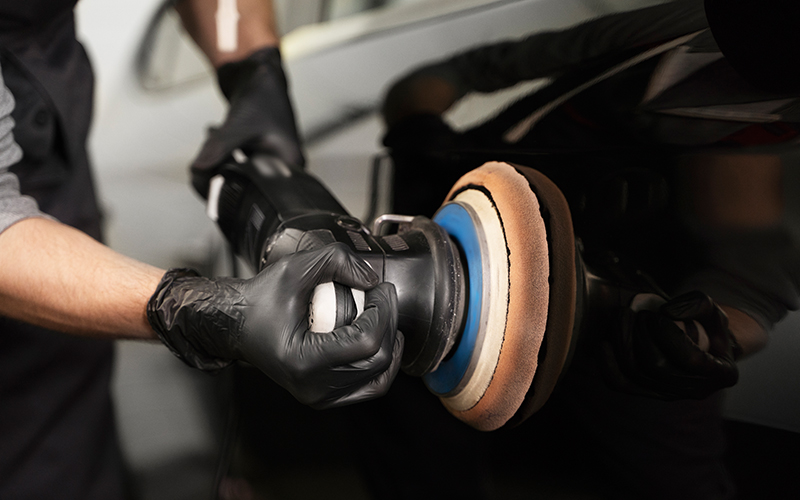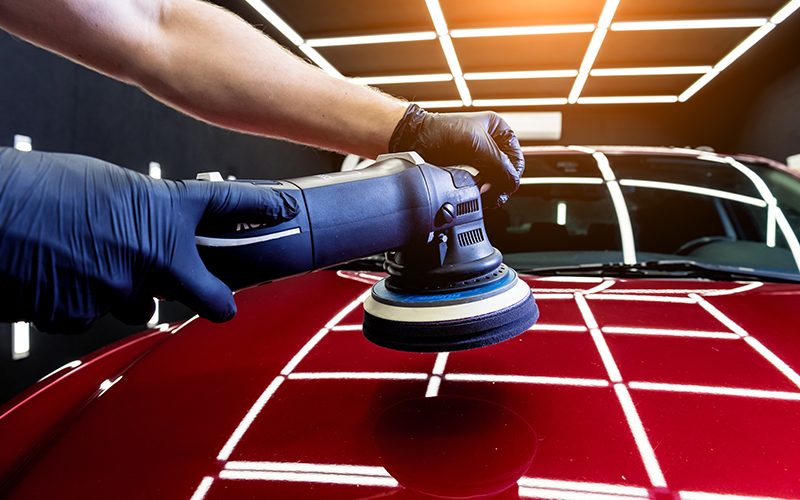Automotive repainting is a crucial aspect of maintaining a vehicle’s visual appeal and protecting its surfaces from various environmental factors. One essential tool that plays a significant role in achieving a flawless finish on freshly painted surfaces is the rotary polisher. This versatile tool has gained popularity among both professional detailers and DIY car enthusiasts for its ability to perfect paint jobs and deliver stunning results.
Rotary polishers work by using a direct-drive motor that causes the polishing pad to rotate in a circular motion. This action generates heat and friction, which in turn effectively removes minor imperfections such as swirl marks, scratches, and oxidation on painted surfaces. When used with the right techniques and polishing compounds, rotary polishers can help achieve a high-gloss, mirror-like finish that showcases an automobile’s paintwork in all its glory.
The key to success with rotary polishers lies in understanding their appropriate usage based on the car’s paint condition and the desired finishing results. By employing the right approach and adhering to proper safety measures, anyone working on automotive repainting can benefit from the efficiency and professional-grade results that rotary polishers offer.
Basic Functionality of Rotary Polishers
Rotary polishers are an essential tool in the automotive repainting process. They are designed to remove paint imperfections, such as swirls, scratches, and oxidation, providing a smooth and even finish on the vehicle’s surface.
Working Mechanism of Rotary Polishers
The working principle of a rotary polisher is based on a powerful motor that spins a polishing pad in a circular motion. The pad’s rotation, combined with the applied pressure and the polishing compound’s abrasive properties, allows it to remove a thin layer of paint, revealing a restored and polished surface.
Rotary polishers offer various speeds, allowing users to adjust the intensity of the polishing process according to the task at hand. It is crucial to use the correct pad and polishing compound, as these factors significantly impact the final result.
In summary, rotary polishers are an indispensable tool in automotive repainting processes, thanks to their efficient working mechanism and adaptability to different polishing tasks. Their ability to remove paint imperfections and restore vehicles’ surfaces to a smooth and even finish makes them a valuable asset in the industry.
Role in Automotive Repainting
Preparation of Vehicle Surface
Before repainting a car, it’s crucial to prepare the vehicle surface properly. Rotary polishers play a vital role in this process. These powerful tools are used to remove old paint, rust, and any imperfections found on the surface. By using different types of polishing pads and compounds, they create a smooth and clean surface, ready for paint.
One of the primary benefits of using a rotary polisher is its ability to cover large areas quickly and efficiently. With the right technique, a professional can remove scratches, swirl marks, and other issues from the vehicle’s surface, ensuring a flawless finish once the new paint is applied.

Application of Paint
After the surface has been prepared, the next step is applying the new paint. Rotary polishers are again essential during this stage of the repainting process. They are used to evenly distribute and blend the paint, ensuring a consistent and professional-looking finish.
Some key aspects of paint application using rotary polishers include:
●Primer: The primer is a crucial first layer of paint that ensures proper adhesion of the topcoat. A rotary polisher can be used to sand the primer, creating a smooth surface for the following layers.
●Basecoat: This is the primary paint color applied to the vehicle. A rotary polisher helps evenly distribute the basecoat and eliminate imperfections.
●Clearcoat: The final layer of paint, the clearcoat, protects the basecoat and provides a glossy finish. Rotary polishers can be used to buff and polish the clearcoat, enhancing the shine and depth of the paint.
Using a rotary polisher during the application of paint ensures an even and high-quality finish. Through meticulous preparation of the vehicle surface and expert application of paint, rotary polishers contribute significantly to the quality and appearance of automotive repainting projects.
Benefits and Challenges
Advantages of Using Rotary Polishers
Rotary polishers are an essential tool for anyone looking to achieve professional-quality results in automotive repainting. There are several advantages to using rotary polishers:
●Efficient removal of imperfections: Rotary polishers generate a high level of heat and friction, effectively removing paint imperfections such as scratches, swirl marks, and oxidation.
●Even application of polish: The consistent rotary motion ensures even distribution of polishing compound, which leads to a smooth and uniform finish.
●Time-saving: Compared to hand polishing, rotary polishers work much faster, allowing you to finish your repainting project more efficiently.
●Flexible: With various pad and attachment options, rotary polishers can be customized to suit different tasks, making them highly versatile.
Possible Difficulties and Solutions
While rotary polishers offer several benefits, there can also be potential challenges when using them. Here are some common issues and their solutions:
●Over-polishing: Excessive use of a rotary polisher can lead to over-polishing, resulting in uneven paint thickness. To avoid this, apply light pressure and keep the tool moving over the surface at a steady pace.
●Heat damage: The high heat generated by rotary polishers can potentially damage the paint or clear coat. Use a lower speed setting and ensure adequate cooling time between passes to prevent heat damage.
●Forming holograms: Inexperienced users may inadvertently create holograms, which are visible circular marks on the paint surface. Proper technique, including the use of a slower speed, lighter pressure, and a finishing pad, can help minimize this risk.
●Learning curve: Mastering the use of a rotary polisher takes practice. Beginners should start on a scrap panel or less-visible area of the vehicle to gain experience and confidence before tackling more prominent surfaces.

Abschluss
Rotary polishers play a significant role in automotive repainting. They are essential tools in achieving a professional and flawless finish. By removing imperfections such as scratches, swirl marks, and oxidation, rotary polishers ensure a smooth surface for the application of new coatings, significantly enhancing the vehicle’s appearance.
While rotary polishers are powerful, their efficiency comes with the requirement of proper handling and technique. It is vital to maintain a steady hand and consistent pressure to prevent paint damage or burns. Additionally, choosing the appropriate speed and pad type ensures the desired results, while also preventing potential harm to the paint.
In summary, the use of rotary polishers in automotive repainting not only enhances the overall aesthetic of a vehicle but also helps prolong its lifespan. Through careful handling and skillful technique, automotive professionals can achieve outstanding results, making rotary polishers an indispensable tool in the repainting process.
